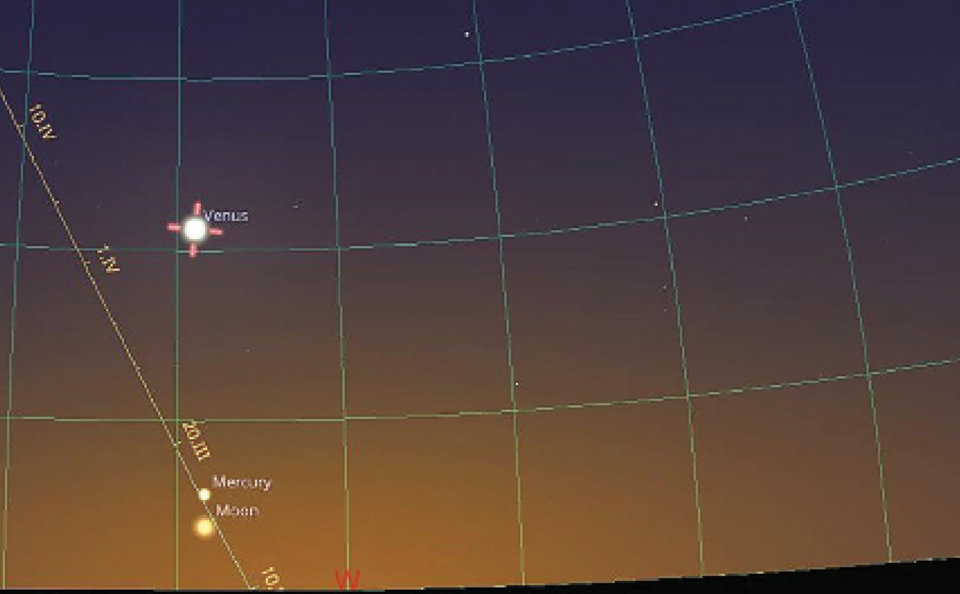The beautiful and uncommonly clear skies we enjoyed for a couple of weeks in January showed us most of our planetary neighbours, with Mars and Jupiter at their brightest. If those clear skies continue, we’re in for a treat.
In the evening before the month begins, Jan. 31 at 18:00, a very thin crescent New Moon is about a hand width above the western horizon. About two lunar diameters above and left is the planet Saturn and above them is the very bright Venus. The next night, the Moon has grown slightly and moved to just left of Venus. What we can’t see without a good telescope is the planet Neptune just about one degree below and right of the Moon. In August 2006, the International Astronomical Union voted to demote Pluto to minor planet status, making Neptune the outermost planet in our solar system. It’s there, just below the Moon, although I doubt I’d be able to pick it out with binoculars at magnitude 7.8.
So, there you have two planets visible above our own and a third if you’ve got a good scope handy. Interestingly, between Feb. 4 and 5, the Moon passes north of the next-to-farthest planet, Uranus. It’s technically visible to the naked eye at magnitude 5.8 although I’ve never managed it that way and only once in a scope. Feb. 6 has the Moon just past first quarter and about five degrees above Jupiter. We’re still pretty close to Jupiter – opposition was in December – so the nightly dance of its four moons can be seen with binoculars. Or check the SCAC website and see if and when the observatory will be open and manned.
The Moon occults Mars on Feb. 9 but again it’s below the eastern horizon so we won’t see it. It will be about 35 degrees above the eastern horizon as the sun sets that day, just below the grouping of Castor, Pollux and Mars. We have now passed Mars which was at opposition on Jan.16 and we’re rapidly pulling away from it. It will lose half its brilliance over the month as we leave it behind.
As I mentioned last month, through a telescope Venus would appear to have grown from a crescent to a half-lit disc on Jan. 12. As it approaches, it will be visible in binoculars growing in diameter but less well lit; at month’s end it will appear as a very thin crescent about one-thirtieth the size of the crescent Moon. The lit portion will be on its lower limb, naturally, but as it swings between us and the Sun, it will be about 8 degrees north of a straight line between us and the Sun. We’ll see it in both evening and morning skies for a few days and it will be a waxing Morning Star by mid-March.
So, February and March offer a chance to see the phases of the Moon with binoculars and those of Venus as well. Granted there’s no particular surface features to be seen on Venus – its clouds look pretty much the same all the time – but seeing phase changes in two objects is a rare twofer.
The end of February is the beginning of an evening appearance by the as yet unmentioned planet, Mercury. It appears by about Feb. 23 just above the western horizon after sunset and climbs towards brilliant Venus. It’s joined by a razor-thin crescent Moon on Feb. 28 at about 18:45.
Lastly, we’re still waiting for the predicted flareup of T Corona Borealis, an aging binary star system in that constellation. The dead core of one of the stars is accreting hydrogen blown off by the other one and eventually the whole works goes thermonuclear and we’ll see what a hydrogen bomb the size of a planet looks like. You can check its brightness goings-on and many other events at https://www.spaceweather.com/
The next SCAC monthly meeting will be at the Sechelt Library, Feb. 14, at 7 p.m. The speaker will be Dr. Shandin Pete, for details please check the club website at: sunshinecoastastronomy.wordpress.com/.



